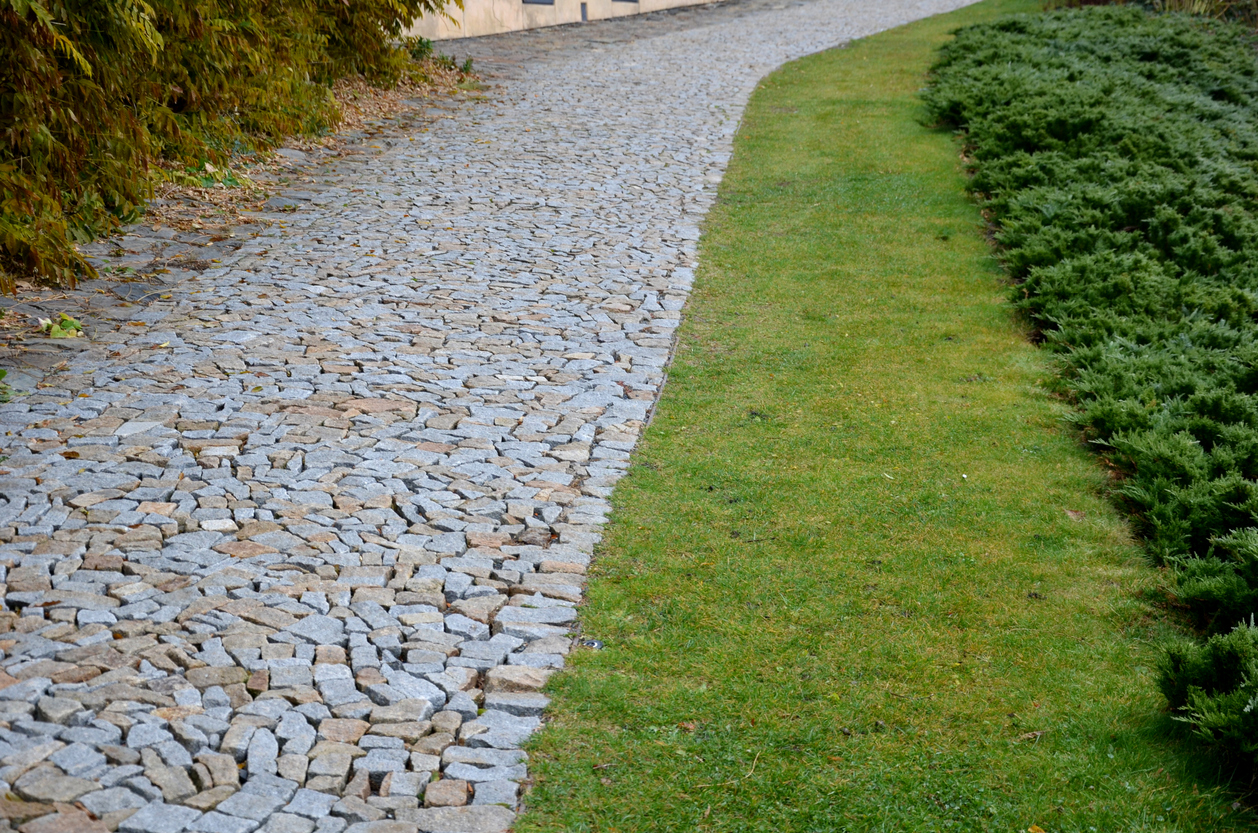The rapid growth of cities is generating a series of urban challenges, one of which is water management. In this context, proper rainwater management is essential to prevent flooding, runoff and other damage. In terms of sustainability, what measures can be implemented?
Rainwater management
Proper rainwater management takes into account the natural water cycle, from the time it is collected on the surface as precipitation, to its final destination, which may be infiltration into the ground or discharge into the general sewerage network until it reaches the sea.
For a rainwater management strategy to be effective, it must encompass all stages of the water cycle in the natural order of its course. Therefore, it will act in the following phases:
- Stop the water at its source: Understanding "origin" as the envelope of the buildings (mainly roof and facade), and the exterior pavements.
- Slowing down the route through the built-up area: The objective is to ensure that the conveyance of rainwater to its final destination is as slow as possible. This strategy acts along the entire path of the runoff, and depends on factors such as surface permeability and vegetation.
- Store surplus water: The objective is to store rainwater for its subsequent reuse and temporary retention before its purification, infiltration, or discharge. Choosing one storage system or another will depend on climatological and orographic factors, as well as the needs of the system.
- Infiltrate water into the ground or reuse it: This final step closes the natural water cycle. Infiltration involves introducing water in a controlled and gradual manner into the soil, allowing its absorption by the ground. Reuse involves regenerating it to give it a second life for uses such as irrigation, street cleaning, vehicle washing, etc.
What are Sustainable Urban Drainage Systems (SUDS)?
Sustainable Urban Drainage Systems (SUDS) are a mature, but still rare solution and therefore a "safe innovation" in urban areas. It arises from the need to address the limitations of existing urban drainage in cities and to carry out a sustainable management of rainwater.
In an increasingly developed urban environment, the soil has become increasingly impermeable, a fact that disrupts the natural hydrological cycle of water causing large volumes of runoff and a longer hydrological response time. Moreover, the loss of vegetation worsens the soil sealing situation. In this context, more and more people are opting for the implementation of sustainable urbanism measures, such as SUDS.
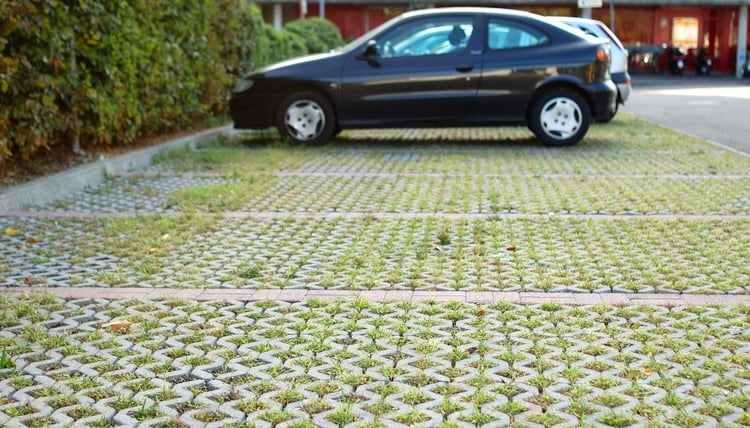
Permeable pavement that allows water infiltration and reduces runoff
In this situation, existing drainage networks are often overwhelmed, causing floods and disruptions in watercourses; as well as material damage and, occasionally, even loss of human lives. Wastewater treatment plants, located at the end of the water's journey, are also affected by this overload.
Expanding conventional drainage networks is not always the most viable option as a solution to this problem. Instead, innovative solutions that complement traditional approaches are required. This is where SUDS come into play, acting as preventive systems and replicating natural hydrological processes.
Ultimately, the aim of the SUDS is to improve drainage in urban areas and to counteract the negative impacts of urbanisation on the water cycle. By preventing water volumes and flows from becoming a problem, these systems contribute to achieving sustainable drainage and improving the quality of water discharged into the environment.
Why are SUDS necessary?
The implementation of Sustainable Urban Drainage Systems (SUDS) is necessary to address a number of issues associated with urban sprawl and inadequate or insufficient stormwater management. Some key reasons are:
- Increased runoff: In urban environments, soil waterproofing due to pavements and constructed surfaces prevents rainwater from infiltrating the ground. This causes a significant increase in runoff, that is, in the amount of water that flows on the surface. SUDS allow reducing this runoff by infiltrating rainwater into the ground, such as green areas. In the following graph, we can see the difference in infiltration volume depending on the type of surface the water flows over.

Source: Flood Risk Adaptation Guidelines(MITECO)
- Groundwater depletion: The waterproofing mentioned in the previous section also causes the depletion of underground water resources, such as aquifers and underground streams. This can lead to structural problems (such as subsidence, landslides, etc.) and biodiversity issues (soil desertification, loss of flora and fauna, etc.).
- Decrease in vegetation: Urban expansion without a sustainable vision has led to the elimination of green areas and planted zones, which play a crucial role in the natural infiltration of water. SUDS counteract this trend by incorporating natural elements, such as landscaped areas, parks, and vegetative filtration systems.
- Peak flow control: During intense rain events, there is a rapid increase in water flow, which can overload conventional drainage systems and cause flooding. SUDS allow for the control and reduction of peak flows by storing rainwater and releasing it gradually and in a controlled manner, thus preventing the saturation of sewer systems and minimizing the risk of flooding.
- Transport of pollutants: Rainwater carries pollutant particles present in the air and on the soil surface, which can lead to the spread of contamination over large areas. SUDS contribute to improving water quality by incorporating granular materials and plants that act as natural filters.

Infiltration trench in green area
Types of SUDS
The different types of SUDS can be grouped into categories depending on the stage of the water cycle in which they act, defining their main function. The most common types of SUDS are:
|
Type of SUDS |
Main function |
Description |
|
Cisterns |
Detention and retention |
They are structures that store rainwater from the roofs of buildings for use in cleaning, irrigation, etc. They can be underground or surface tanks. |
|
Green roofs |
Detention |
They consist of a layer of plants growing on the roof surface of buildings. These covers retain part of the rainwater, reducing the runoff. Additionally, they provide additional benefits such as improved thermal insulation and reduction of the heat island effect. |
|
Floodable flowerbeds |
Detention and infiltration |
These landscaped areas receive and temporarily store surface runoff waters, and are built on very permeable ground. The vegetation present in them helps to eliminate carried particles and pollutants. |
|
Vegetated ditches |
Treatment |
They are shallow channels covered with vegetation that receive and transport runoff water from adjacent impermeable areas. These linear structures, generally located on the sides of roads, are designed to allow the sedimentation of particles and absorption of pollutants. |
|
Permeable pavements |
Infiltration |
They are pavements that allow water to pass through them, facilitating its direct infiltration into the ground or its storage for later reuse. |
|
Bioretention strips |
Infiltration and treatment |
These strips, composed of a combination of vegetation and a specific substrate, have a high capacity to retain sediments and pollutants, making them a suitable option for treating runoff water with a certain degree of contamination, such as that from roadways. |
|
Wetlands and artificial ponds |
Treatment |
Wetlands covered with vegetation and filled with water of varying depths. These systems promote biodiversity and the proliferation of flora and fauna. They can be used to treat rainwater through organic processes, offering an alternative to sewage treatment plants. |
Cases of SUDS implementation
The implementation of SUDS has gained popularity over the past few years due to its practicality and efficiency when implemented correctly. Here are some examples where sustainable measures have been applied in rainwater management.
Implementation of SUDS in Valdebebas, Madrid
Susana Canogar, in her article "The social and environmental value of the SUDS", details one of the rainwater management projects in the northern area of Madrid, specifically in Valdebebas. This is an urban development of 1,065 hectares, in which 24 hectares of urban green areas were developed in the initial phase of the project. These areas included green connectors and landscaped boulevards to fulfil environmental functions, such as the sustainable urban drainage system SUDS.
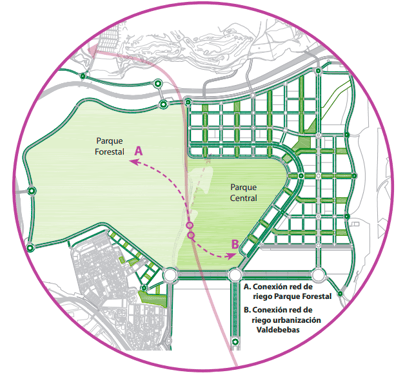 One of the main thrusts of this project was to explore how to contribute to a reduction in water use. Valdebebas was therefore connected to the municipal network of reclaimed water, in addition to adapting water use to the regulations (consumption of 2,500 m3/ha), with measures such as the creation of a sustainable drainage system, where the paving of paths and squares was designed to slope towards the flowerbeds to increase water collection. Wells were also installed at the low points of the boulevards to collect water that was not absorbed by the ground and a construction detail was developed for permeable paving, using precast concrete slabs with a 1 cm joint.
One of the main thrusts of this project was to explore how to contribute to a reduction in water use. Valdebebas was therefore connected to the municipal network of reclaimed water, in addition to adapting water use to the regulations (consumption of 2,500 m3/ha), with measures such as the creation of a sustainable drainage system, where the paving of paths and squares was designed to slope towards the flowerbeds to increase water collection. Wells were also installed at the low points of the boulevards to collect water that was not absorbed by the ground and a construction detail was developed for permeable paving, using precast concrete slabs with a 1 cm joint.
Based on studies that have been carried out to test the performance of the system, it was concluded that the use of SUDS in Valdebebas leads to a 10% reduction in energy consumption and GHG emissions.
Urban actions in Valencia, Xàtiva
In the Valencian municipality of Xàtiva, which belongs to a climatological zone with episodes of torrential rains and flood risk, there have been collapse problems in the sanitation network due to the heavy rains. This has led to the spread of polluted water and its discharge into the river Albaida, making it necessary to implement measures to achieve proper water management in the area.
To this end, a vegetated roof was built in the City of Sports, which collects the runoff water and directs it to a detention and infiltration basin. Thanks to this intervention, the drainage of the road is improved, the peak flow of the sewer network is reduced, and the quality of the water discharged into the Albaida River is improved.
At the Gonzalbes Vera public school, three actions were carried out: the transformation of part of the roof into a green roof or vegetated roof, the permeable paving of a section of the courtyard, and the installation of a cistern to store rainwater and use it for irrigation and cleaning. These interventions not only have environmental benefits, but also serve an educational function.
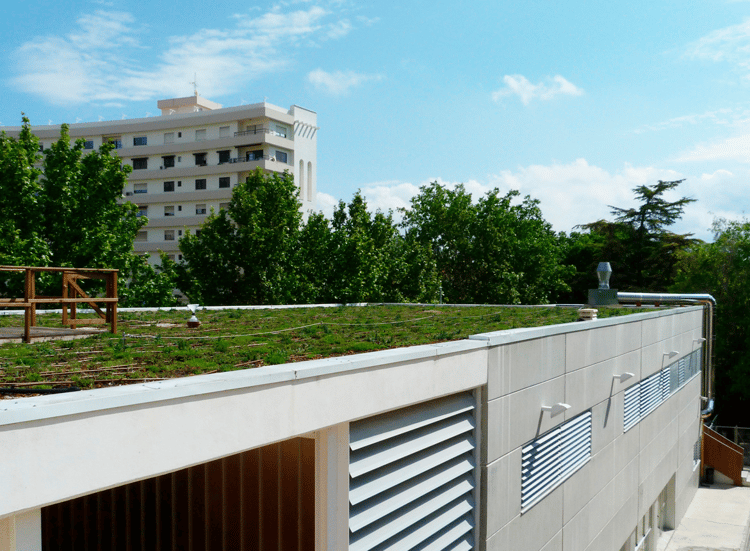
Green roof installed at the Golzalbes Vera public school, Xàtiva. Source: Paimed
Implementation of SUDS in the Zona Franca, Barcelona
Another case of the implementation of sustainable rainwater management systems is the Marina de la Zona Franca neighbourhood in Barcelona. This project focuses on integrating the rainwater network into the building and public space to manage urban runoff and prevent flooding, as Barcelona is characterised by its highly impermeable terrain.
The SUDS system designed for the project focuses on the collection and transport of runoff from pedestrian areas, as well as rainwater from the building's stormwater network. Thanks to vegetated ditches and permeable pavement strips, rainwater is collected and transported to other green areas.
The main objective of this process is to reduce the volume of rainwater discharged into the combined sewer system and, at the same time, infiltrate and recharge natural aquifers. The implemented system has successfully managed 90% of the runoff, while only the remaining 10% reaches the combined sewer system.
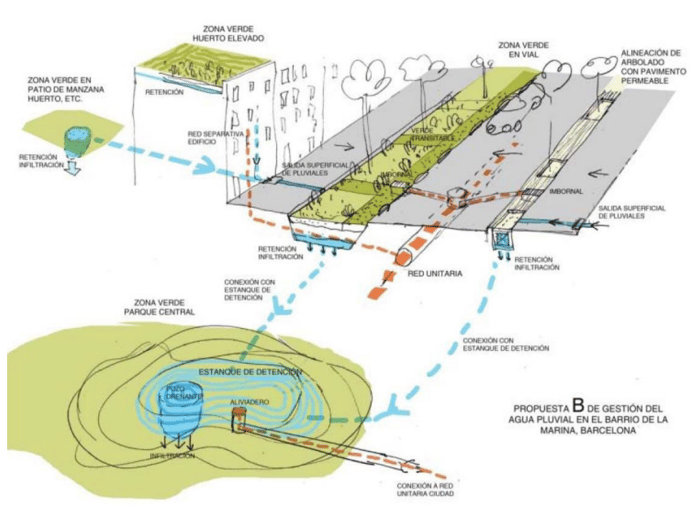
SUDS systems scheme in the Marina de Zona Franca. Source: Flood Risk Adaptation Guidelines(MITECO)
In conclusion, Sustainable Urban Drainage Systems (SUDS) represent an innovative and effective strategy to address the challenges related to rainwater management in urban environments. As cities continue to cope with population growth and climate change, it is essential to adopt sustainable approaches that promote sound water management and minimise negative impacts on the environment.

